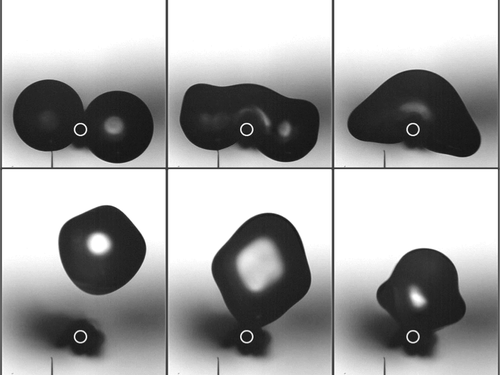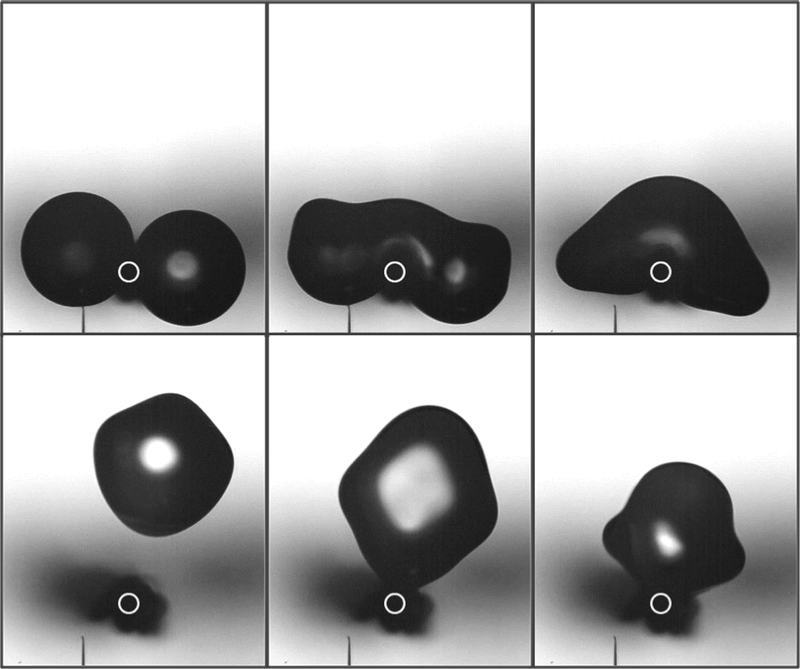Self-Removing Droplets
Technology that removes fine liquid droplets from a gas is important in water purification, moisture harvesting from the atmosphere, and a variety of industrial processes. A common method is to use a mesh of fine fibers that the droplets stick to, but the challenge is then to strip them from the fibers so that more can be gathered. New experiments, backed up by numerical simulations, show that an appropriate choice of fiber composition and width can make the droplets self-removing: the energy released as they coalesce is sufficient to propel them from the strands. This new design could improve the efficiency of droplet collectors.
Liquid drops tend to be spherical, as this shape minimizes surface area for a given volume, thus minimizing the energy associated with surface tension. For the same reason, drops that come into contact coalesce to reduce their total surface area. Fiber-based coalescers rely on this principle. Fine aerosol drops collect on the fibers and merge, and when they get large enough, they drain away under their own weight, or can be shaken loose. If the removal process is not efficient, however, the fibers may clog, slowing down droplet collection.
Chuan-Hua Chen of Duke University in Durham, North Carolina, and his colleagues have now designed fibers from which merged droplets above a certain size expel themselves without any assistance. The design springs indirectly from earlier work by Chen and Duke colleague Jonathan Boreyko on superhydrophobic (highly water-repelling) surfaces. Seeking to keep their contact area to a minimum, droplets on such surfaces bead up almost into spheres. Chen and Boryeko found that as droplets merged, they would spring spontaneously off the surface, because some of the surface energy released as the drops coalesced would turn into mechanical energy that was enough to detach the drop altogether [1]. But making surfaces superhydrophobic is hard, requiring a nanoscale texture or some other complicated surface design.
Chen and co-workers have now shown that droplets can self-eject from a much less hydrophobic surface, if it is in the form of a narrow fiber. They see the effect for fine copper wire coated with a smooth layer of Teflon (the plastic often used as a nonstick coating for cookware). “Self-removal is essentially inevitable as long as the surface is reasonably hydrophobic,” says Chen. It doesn’t happen for a polystyrene coating, though, since this plastic isn’t water-repelling enough.
The team also performed numerical simulations that showed how the interaction of the fiber with merging droplets leads to ejection. In trying to reduce its contact with the fiber, the coalesced droplet bulges out to one side. Its inertia then keeps it moving in the same direction, overcoming the relatively weak adhesion to the fiber. Detachment occurs only when the ratio of the droplet radius to the fiber radius is greater than a critical value. The more this ratio exceeds the critical value, the greater the speed with which the merged droplet is launched.
Chen and colleagues say that self-removal of droplets should also be possible for an emulsion, where both the droplets and their surrounding medium are liquids—as long as the liquids are not too viscous. As droplets coalesce, they settle out of the emulsion by gravity. This would offer a way of separating two immiscible but finely blended liquids, for example, oil contaminating water or vice versa.
“This is the first time such an effect has been demonstrated and documented on curved substrates such as fibers,” says Gareth McKinley, a mechanical engineer at the Massachusetts Institute of Technology in Cambridge. Compared to the same phenomenon on flat surfaces, “the curvature of the fiber surface helps to significantly amplify the ejection velocity of the droplets as they leave the fiber.” He adds that the effect might find applications in industrial mist collectors and coalescers, where the goal is to remove fine droplets of waste products out of a gas stream. For atmospheric water harvesting, it remains to be seen whether the fine fibers required would withstand the high wind speeds sometimes encountered in an outdoor setting, he says.
This research is published in Physical Review Letters.
–Philip Ball
Philip Ball is a freelance science writer in London. His latest book is How Life Works (Picador, 2024).
References
- J. B. Boreyko and C.-H. Chen, “Self-Propelled Dropwise Condensate on Superhydrophobic Surfaces,” Phys. Rev. Lett. 103, 184501 (2009).





